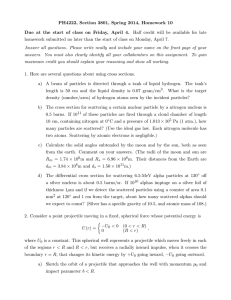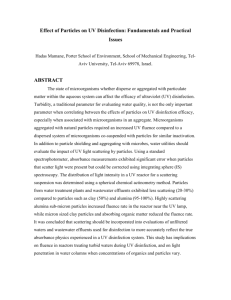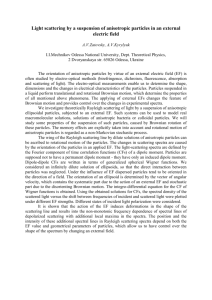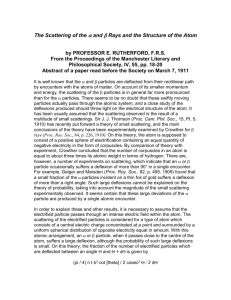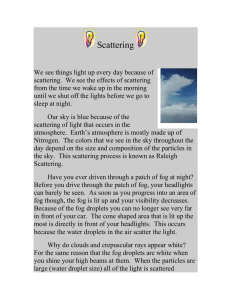Lecture 4
advertisement
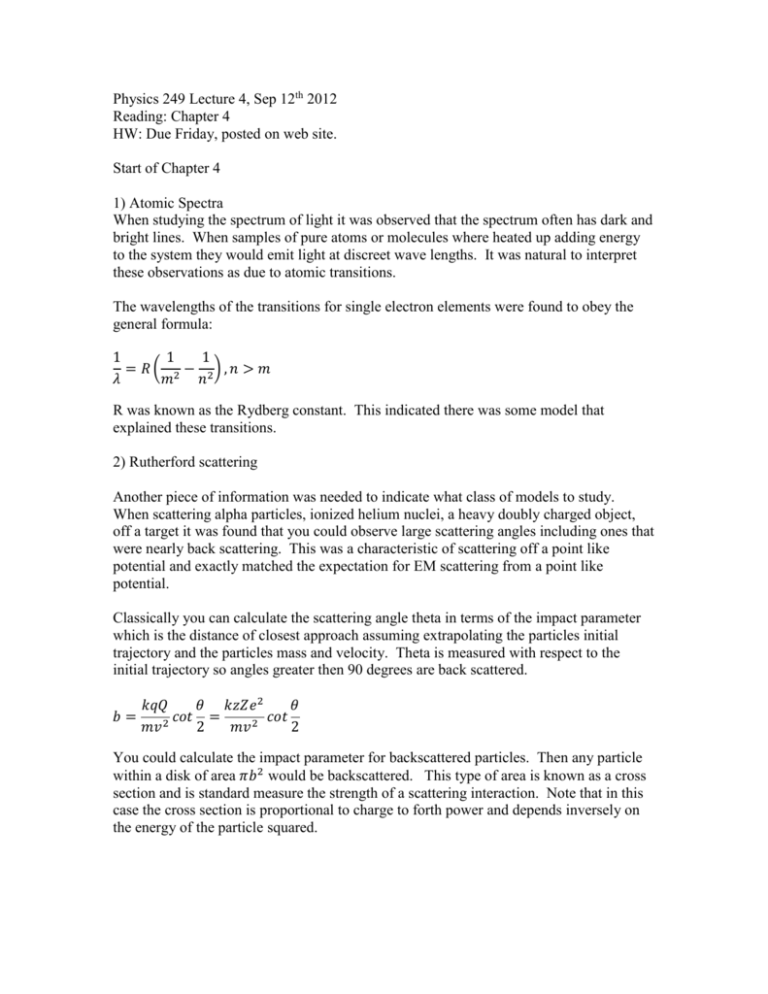
Physics 249 Lecture 4, Sep 12th 2012 Reading: Chapter 4 HW: Due Friday, posted on web site. Start of Chapter 4 1) Atomic Spectra When studying the spectrum of light it was observed that the spectrum often has dark and bright lines. When samples of pure atoms or molecules where heated up adding energy to the system they would emit light at discreet wave lengths. It was natural to interpret these observations as due to atomic transitions. The wavelengths of the transitions for single electron elements were found to obey the general formula: 1 1 1 = 𝑅 ( 2 − 2) , 𝑛 > 𝑚 𝜆 𝑚 𝑛 R was known as the Rydberg constant. This indicated there was some model that explained these transitions. 2) Rutherford scattering Another piece of information was needed to indicate what class of models to study. When scattering alpha particles, ionized helium nuclei, a heavy doubly charged object, off a target it was found that you could observe large scattering angles including ones that were nearly back scattering. This was a characteristic of scattering off a point like potential and exactly matched the expectation for EM scattering from a point like potential. Classically you can calculate the scattering angle theta in terms of the impact parameter which is the distance of closest approach assuming extrapolating the particles initial trajectory and the particles mass and velocity. Theta is measured with respect to the initial trajectory so angles greater then 90 degrees are back scattered. 𝑏= 𝑘𝑞𝑄 𝜃 𝑘𝑧𝑍𝑒 2 𝜃 𝑐𝑜𝑡 = 𝑐𝑜𝑡 2 2 𝑚𝑣 2 𝑚𝑣 2 You could calculate the impact parameter for backscattered particles. Then any particle within a disk of area 𝜋𝑏 2 would be backscattered. This type of area is known as a cross section and is standard measure the strength of a scattering interaction. Note that in this case the cross section is proportional to charge to forth power and depends inversely on the energy of the particle squared. Consider the number back scattered from a beam of cross sectional area A, of intensity or number of particles per unit area per second I, and given the number density of atom per unit volume in the target n. ntA gives the number of targets seen by the bean in time t. 𝑁 = 𝜋𝑏 2 IntA 3) Differential cross section of Rutherford scattering. A more complete answer to this problem involves understanding the distribution of particles as a function of angle given a large beam(compered to target spacing). Consider incident particles in a washer shaped area with impact parameters in db around b. This washer has area: 𝑑𝜎 = 2𝜋𝑏𝑑𝑏 They will be deflected into a conical wedge with in 𝑑𝜃 around 𝜃. We can further subdivide into differential areas by considering angles 𝑑𝜙 around 𝜙 𝑑𝜎 = 𝑑𝜙𝑏𝑑𝑏 and number of particles passing through it 𝑑𝑁(𝜃, 𝜙) = 𝐼𝑑𝜎 = 𝑑𝜙𝐼𝑏𝑑𝑏 then you can define the differential cross section in area 𝑑Ω as: 𝑑𝜎 1 𝑑𝑁(𝜃, 𝜙) 𝑑𝜙𝑏𝑑𝑏 𝑏 𝑑𝑏 = = = 𝑑Ω 𝐼 𝑑Ω 𝑑𝜙𝑠𝑖𝑛𝜃𝑑𝜃 𝑠𝑖𝑛𝜃 𝑑𝜃 However I have an expression for b in terms of 𝜃: 𝑑𝑏 𝑘𝑧𝑍𝑒 2 𝜃 2 = 𝑐𝑠𝑐 𝑑𝜃 2𝑚𝑣 2 2 2 𝜃 𝑐𝑜𝑠 2 1 𝑑𝜎 𝑏 𝑑𝑏 1 𝑘𝑧𝑍𝑒 𝜃 𝑘𝑧𝑍𝑒 𝜃 1 𝑘𝑧𝑍𝑒 1 = = 𝑐𝑜𝑡 𝑐𝑠𝑐 2 = ( ) 𝑑Ω 𝑠𝑖𝑛𝜃 𝑑𝜃 𝑠𝑖𝑛𝜃 𝑚𝑣 2 2 2𝑚𝑣 2 2 8 1 𝑚𝑣 2 𝑠𝑖𝑛𝜃 𝑠𝑖𝑛 𝜃 𝑠𝑖𝑛 𝜃 2 2 2 2 2 2 2 2 𝜃 𝑐𝑜𝑠 2 1 𝑑𝜎 1 𝑘𝑧𝑍𝑒 2 1 1 𝑘𝑧𝑍𝑒 2 1 = ( ) = ( ) 𝑑Ω 16 1 𝑚𝑣 2 𝑠𝑖𝑛 𝜃 𝑐𝑜𝑠 𝜃 𝑠𝑖𝑛 𝜃 𝑠𝑖𝑛2 𝜃 16 1 𝑚𝑣 2 𝑠𝑖𝑛4 𝜃 2 2 2 2 2 2 2 Which is called the differential cross section. For a number of particles: 2 𝑑𝜎 𝐼 𝑘𝑧𝑍𝑒 2 𝑑Ω 𝑑𝑁(𝜃, 𝜙) = 𝐼𝑑𝜎 = 𝐼 𝑑Ω = ( ) 𝑑Ω 16 1 𝑚𝑣 2 𝑠𝑖𝑛4 𝜃 2 2 2 𝑑𝑁(𝜃) 𝐼 𝑘𝑧𝑍𝑒 2 1 = ( ) dΩ 16 1 𝑚𝑣 2 𝑠𝑖𝑛4 𝜃 2 2 This was for one target. Multiply by the number of targets seen by the beam in t: ntA 2 2 𝑑𝑁(𝜃) 𝐼𝑛𝑡𝐴 𝑘𝑧𝑍𝑒 1 = ( ) dΩ 16 1 𝑚𝑣 2 𝑠𝑖𝑛4 𝜃 2 2 Note on the range of impact parameters this formula is valid for. Nuclei are on order 1x10-15m or one Fermi in radius. You can calculate the distance of closest approach for head on collision of a given energy by simply equating the kinetic energy and the Coulomb potential energy. To approach at the order of Fermi’s relativistic speeds are necessary. Any lesser energy is going to see the nucleus as equivalent to a point charge.
